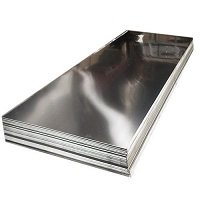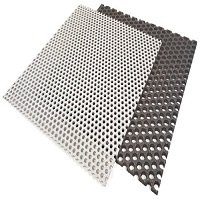
Silicon Steels is one of the top in the industry in manufacturing, supplying, stocking, and exporting Stainless Steel SMO 254 Sheets / Plates. The sheet material known as Stainless Steel SMO 254 is austenitic steel. It has an outstanding level of tensile strength. The stainless steel SMO plate has the greatest material corrosion resistance. Its thickness may vary anywhere from 4 millimetres to 100 millimetres. Sheets made of stainless steel SMO 254 may be found in a variety of sizes and forms, and customers can get these sheets in accordance with the modification they want. Stainless Steel SMO 254 Coils provide the highest level of corrosion resistance possible when exposed to a chemical environment. It has excellent ductility as well as durability./
Stainless Steel SMO 254 Sheets possesses high tensile strength and toughness. It has the best corrosion resistance to pitting and crevice corrosion. Stainless Steel SMO 254 Sheets contains nickel content up to 19%, chromium content up to 21%, and molybdenum content up to 7%. It has outstanding corrosion resistance to stress corrosion cracking. It possesses high yield strength. Stainless Steel SMO 254 Sheets also contains 1% manganese content, 1% copper content, and sulfur content up to 0.01%. It offers excellent corrosion resistance to intergranular corrosion and general corrosion. Stainless Steel SMO 254 Coils have the best corrosion resistance to seawater corrosion.
Stainless Steel SMO 254 Sheets are often used in the marine industry, offshore oil drilling companies, and seawater equipment. It also used in chemical equipment and pharmaceutical equipment. Stainless Steel SMO 254 Coils are used in food processing equipment and food packaging equipment. Stainless Steel SMO 254 Plates are mostly used in the pulp and paper industry. It can be used extensively used in the petroleum industry.
| Specifications | ASTM A240 / ASME SA240 |
| Thickness | 4mm-100mm |
| Width | 1000mm, 1219mm, 1500mm, 1800mm, 2000mm, 2500mm, 3000mm, 3500mm, etc |
| Length | 2000mm, 2440mm, 3000mm, 5800mm, 6000mm, etc |
| Surface | 2B, 2D, BA, NO.1, NO.4, NO.8, 8K, mirror, checkered, embossed, hairline, sand
blast, Brush, etching, etc |
| Finish | Hot rolled plate (HR), Cold rolled sheet (CR), 2B, 2D, BA NO(8), SATIN (Met with Plastic Coated) |

|
|
|
|

|
|
|
|

|
|
|
|

|
|
|
|

|
|
|
|

|
|
|
|

|
|
|
|

|
|
|
|

|
|
|
|

|
|
|
|

|
|
|
|

|
|
|
|
| STANDARD | UNS | WERKSTOFF NR. | AFNOR | EN | JIS | SIS | GOST |
| SMO 254 | S31254 | 1.4547 | Z1 CNDU 20.18.06Az | X1CrNiMoCuN20-18-7 | – | 2378 | – |
| Grade | Ni | C | Mo | Mn | Si | Fe | Cu | S | P | Cr |
| SMO 254 | 17.5 – 18.5 |
0.02 max | 6 – 6.5 |
1 max | 0.8 max | – | 0.5 – 1 | 0.01 max | 0.03 max | 19.5 – 20.5 |
Stainless Steel SMO 254 Plate Metric Dimensions
| Surface finish | Thickness (mm) | Width (mm) |
|---|---|---|
| 2B – Cold rolled, heat treated, pickled, skin passed | 0.25–8.0 | max. 2032 |
| 2D – Cold rolled, heat treated, pickled | 0.4–6.35 | max. 1524 |
| 2E – Cold rolled, heat treated, mechanically descaled | 0.4–8.0 | max. 2032 |
| 2R – Cold rolled, bright annealed | 0.25–3.5 | max. 1524 |
| 2H – Work hardened | 0.4–6.35 | max. 1524 |
| Polished, brushed | 0.5–4.0 | max. 1524 |
Imperial Dimensions of Stainless Steel SMO 254 Sheet
| Surface finish | Gauge (in) | Width (in) |
|---|---|---|
| 2B – Cold rolled, heat treated, pickled, skin passed | 10–24 | max. 72* |
| 2D – Cold rolled, heat treated, pickled | 12–24 | max. 60 |
| BA Mexinox only | 18–28 | max. 48 |
| Polished (not brushed) | 11–24 | max. 60 |
| Temper rolled Mexinox only | 13–29 | max. 48 |
| Thickness | Plate Weight per Unit Area | Density |
|---|---|---|
| 3/16 inches | 0.06000 lbs/in²42.184176 kg/m² | 0.315 lbs/in³8.72 g/cm³ |
| 1/4 inches | 0.08 lbs/in²56.245568 kg/m² | 0.315 lbs/in³8.72 g/cm³ |
| 3/8 inches | 0.121 lbs/in²85.0714216 kg/m² | 0.315 lbs/in³8.72 g/cm³ |
| 1/2 inches | 0.161 lbs/in²113.1942056 kg/m² | 0.315 lbs/in³8.72 g/cm³ |
| 5/8 inches | 0.196 lbs/in²137.8016416 kg/m² | 0.315 lbs/in³8.72 g/cm³ |
| 3/4 inches | 0.235 lbs/in²165.221356 kg/m² | 0.315 lbs/in³8.72 g/cm³ |
| 7/8 inches | 0.274 lbs/in²192.6410704 kg/m² | 0.315 lbs/in³8.72 g/cm³ |
| 1 inches | 0.313 lbs/in²220.0607848 kg/m² | 0.315 lbs/in³8.72 g/cm³ |
| 1 1/4 inches | 0.391 lbs/in²274.9002136 kg/m² | 0.315 lbs/in³8.72 g/cm³ |
| 1 1/2 inches | 0.47 lbs/in²330.442712 kg/m² | 0.315 lbs/in³8.72 g/cm³ |
| 1 3/4 inches | 0.549 lbs/in²385.9852104 kg/m² | 0.315 lbs/in³8.72 g/cm³ |
| 2 inches | 0.627 lbs/in²440.8246392 kg/m² | 0.315 lbs/in³8.72 g/cm³ |
| 2 1/4 inches | 0.705 lbs/in²495.664068 kg/m² | 0.315 lbs/in³8.72 g/cm³ |
| 2 1/2 inches | 0.784 lbs/in²551.2065664 kg/m² | 0.315 lbs/in³8.72 g/cm³ |
| 2 3/4 inches | 0.862 lbs/in²606.0459952 kg/m² | 0.315 lbs/in³8.72 g/cm³ |
| 3 inches | 0.941 lbs/in²661.5884936 kg/m² | 0.315 lbs/in³8.72 g/cm³ |
These material are not a single material but the name for a family of corrosion resistant steels. Like many scientific breakthrough the origins of stainless steel lies in a lucky accident. From the smallest part of zipper to the largest building skyscraper, stainless steel is an essential part of modern life.Stainless steel’s strength, resistance to corrosion and low maintenance make it the ideal material for a wide range of applications. It is also has a long life cycle and is 100% recyclable.
We ship our stainless steel metal products in industry leading packaging designed to ensure your order reaches its destination safely. We offer multiple packaging options to meet your specific requirements. Packing is quite important especially in a case of international shipments in which consignment pass through various channels to reach the ultimate destination, so we put special concern regarding packaging. We pack our goods in numerous ways based on the products. We pack our products in multiple ways.
To specify the various physical and mechanical properties of the finished product, various tests, both destructive and nondestructive, are performed. Metallurgical, hardness, hardenability, tension, ductility, compression, fatigue, impact, wear, corrosion, creep, machinability, radiography, magnetic particle, ultrasonic, and eddy current are some of the major tests that are performed by quality control personnel. Metallurgical testing is used to determine the quality of steel by analyzing the microstructure of a sample under a microscope. A cross section of a sample is first highly polished and then examined at a magnification from 100-500 diameters. The microstructure of steel consists of grains of different compositions and sizes.